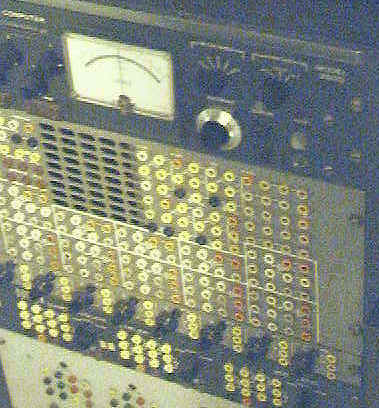|
ANALOG COMPUTERS Analog computers are electro
mechanical or electronic computers used to solve engineering problems
related to time dependant differential equations especially where
non-linear aspects such as discontinuities are involved. Nowhere near as
precise as modern digital computers, the solution results are adequate for
engineering analysis and occur right away as opposed to all but the latest
high speed, large memory digital machines. Early Development Starting in the 1930’s, MIT
and other locations developed electro mechanical machines that were
collections of gears, shafts and, to perform integration,
a necessity to solve differential equations, a ball and disk
assemble was used . This mechanism would give the integral of the ball
position and rotation by the rotation of the disk. This led to the
development of several devices used during WW2. Among these are:
Nordon Bombsight: This
then quite secret device allowed inputs of airplane speed, wind speed, and
air temperature combined with optical input by the bpmbardier. The output
controlled the plane during the last moments of a bomb run and toggle bomb
release. The results were far from perfect but better than other methods
then in use.
B-29 Fire Control: Unlike
earlier bombers where defensive fire was done by gunners directly
operating machine guns, the B-29 used remotely operated guns controlled by
separate sighting stations that fed an analog computer with target
location, range and relative speed and which calculated the predicted path
of the target and fired the guns.
Anti-Aircraft Gun Control: Similar
to the B-29 fire control. Optical or radar was used as input to an analog
computer along with wind and air temp and nature of the shell to predict
the appropriate firing time and direction. Post WW2: Following WW2, significant
development of analog computers took place as the rise of electronics led
to the development of very high gain amplifiers allowed for fully
electronic analog computers. High gain amps that are linear in the
frequency range of signals used in analog computers can sum signals when
used with resistive feedback (usually 1 meg-ohm) and as an integrator with
capacitive feedback (usually 1 micro-farad). The examples below are
typical of analog design and use in the period 1950 thru1979.
Link Aviation C8 The
C8 was a mostly electronic analog flight simulator of a generic, early jet
aircraft such as the F80 – and used by the USAF in the early 1950’s.
Some electro-mechanical elements were left – motor driven potentiometers
primarily – were still present but most of the flight characteristics
were simulated with vacuum tube amplifiers. This product had no motion
capabilities such as modern flight simulators or the legendary ANT-18.
Boeing Airplane Co:
BEAC: The
Boeing Electronic Analog Computer was developed by Boeing to work on
aerodynamic problems. While some thoughts were to make it a commercial
product, this effort was dropped when really slick commercial products
became available. The computer was housed in standard relay racks with
large and awkward connecting cables.
PACE and EASE These
two analog computers were quite similar and featured exchangeable patch
panels. These 24 x 18 aluminum panels allowed the setup of problems so
that the computer could be easily switched from one problem to another.
Some of the problems that these computers were used for are: 707
Anti-Skid Design The
anti-skid was developed for the 707 braking system and is the forerunner
for airplanes and automobiles. The analog computer was used to analyze the
forces and sensors needed to relieve the braking pressure when a skid is
about to start. 707
Shock Absorber Metering Pin Airplane
shock absorbers are built with a metering pin that regulates the flow of
hydraulic fluid depending on the depression and depression velocity of the
landing gear. This problem, before computers, was done by controlled
dropping an airplane from various heights. This often led to damage to the
test airplane.
Thermodynamics of a Reentry Ball The USAF contracted with Boeing to determine what
level of thermodynamic problems could be solved with various computing
methods. A series of problems of increasing difficulty was produced sand
solutions were attempted starting with slide rule and working up to large
digital and analog computers. The final one of these was an ablative ball
returning from space. The ball was made of several layers with different
thermodynamic properties including one liquid layer that would go from
liquid to gas when the heat was sufficient. The problem was to graph the
heat transfer from outside to center as a function of time. The analog
solution was developed considerably faster than the 5digital solution. A
copy of the analog solution setup is attached.
Wing Loading Analysis Computer This
one of a kind passive element (no amplifiers)
was built to study wing loading for the 707 during the 707 development
cycle.
Tektronix Inc. In
order to improve the design of peaking circuits used in its high
performance oscilloscopes, Tektronix built a Heath Kit analog computer and
used it to simulate the effects of component variation.
University of Oregon The
University of Oregon had a requirement for a new science bldg that spanned
an extant street and had, because of laboratory requirements, a very
irregular pattern of windows. These led to the requirement that the
building frame be outside the curtain wall thus forming a pleasing visual
aspect. An opinion was formed that an indeterminate truss structure would
be best and might save steel quantities. An indeterminate truss is made of
elements that are rectangles with additional members between diagonal
corners forming an ‘X’. If the diagonal members are not tied together
the resulting stress loading and bending moments can be solved by
analytical methods but, when tied together become indeterminate by
analytical methods. A small, passive element, analog computer was built to
study the problem with results showing the resulting structure would be
very stiff and use much less steel.
|

Our Syston Donner analog Computer at SMECC |
